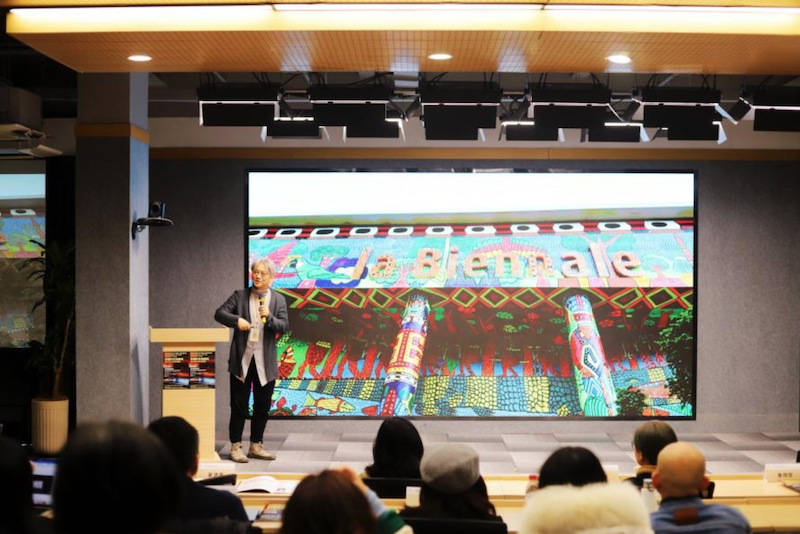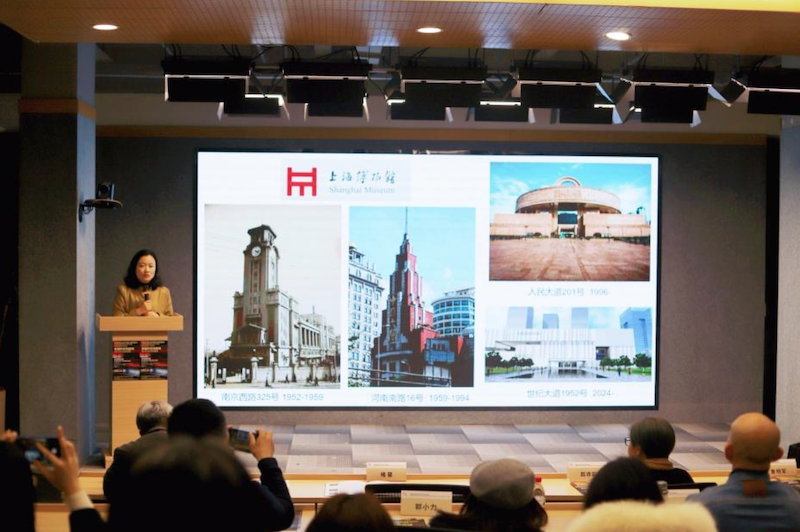
The Paper learned that the international academic seminar "Echoes Across Time and Space: Contemporary Art and Historical Relics" hosted by the Dunhuang Contemporary Art Museum was recently held at the C4 Chuanggu Theater in Changyang, Shanghai. At the event, more than 10 scholars and artists discussed the three themes of "time dislocation" and the value of cultural relics, artistic creation and historical relics, the reshaping of the concept of time and space through exhibition practice, and the reinterpretation of historical relics.
How art exhibitions deal with historical relics
At the seminar "Echoes Across Time and Space: Contemporary Art and Historical Relics", Wu Hongliang, President of the Beijing Academy of Painting, discussed the topic of "Curating and Empathy Field: How to Activate the Link between Tradition and the Contemporary through Exhibitions", and the core of curating is to break the binary opposition between tradition and the contemporary and build a bridge of emotional resonance. He said that although curating originated from Western concepts, it has a unique transformation in China. The ancient word "策" means power, direction, motivation and wisdom. Curating is like compiling history, connecting different artworks and concepts to promote the continuation and development of art. Finally, he quoted Mr. Huang Yongyu's words: "Beauty is easy to disappear, and the mission of art is to retain it."

Wu Hongliang gave a speech at the seminar
Chu Xin, director of the Exhibition Department of Shanghai Museum, discussed how traditional museums can integrate contemporary art elements with the theme of "Contemporary Thinking of Art Exhibition Planning". She shared several exhibition cases of Shanghai Museum in recent years, such as the "Top of the Pyramid" exhibition, which used immersive technology to reproduce ancient Egypt, the "Dialogue with Leonardo da Vinci" exhibition, which put Italian classics on the same stage with Chinese calligraphy and painting, presenting a dialogue between the spirit of craftsmen in the East and the West, and the "Garden of Flowers" exhibition, which combined jewelry display with contemporary art curation. These cross-cultural curatorial methods not only broadened the expression dimension of the exhibition, but also provided reference for the curation of art museums.

Chu Xin gave a speech at the seminar

The “Garden Full of Flowers” exhibition features creative scene design by the artificial intelligence model cAI™ (pronounced AI Cai) created by Cai Guo-Qiang’s team
Zhou Shiyan, a professor at the China Academy of Art, used Liao Dynasty architecture as a starting point to reveal the "dynamic vitality" of historical relics. By comparing the structures of the Guanyin Pavilion of Dule Temple in Ji County and the Wooden Pagoda in Ying County, she described the complexity of Liao Dynasty architecture in integrating nomadic and Central Plains civilizations - Khitan craftsmen, on the basis of inheriting the technology of the Tang Dynasty, creatively adopted the "forked column structure" and "wrapped column structure", making the architecture both majestic and agile. She emphasized the contemporaneity of Liao Dynasty architecture in a specific historical context, and pointed out that it was a rare moment when creativity was released.

Guanyin Pavilion of Dule Temple (Spring 1932), Liang Sicheng was the one who built the upper floor

Cross-section of Guanyin Pavilion
Chen Yan, associate professor at Shanghai Normal University, used Kircher's Illustrated History of China in the 17th century as an example to analyze the phenomenon of "anachronism" in cross-cultural image translation. He said that although Kircher mistranslated the Chinese Bodhisattva as the Egyptian god Harpocrates, it was a misreading, but it gave birth to the cultural imagination of the East in the European Enlightenment and formed a new visual expression. Chen Yan said that this "productive misreading" not only has historical significance, but also provides inspiration for contemporary art. "When facing historical and cultural heritage, contemporary art should inspire new artistic languages through translation and re-creation, rather than simply reproducing them."
Fudan University professor Lu Mingjun took Robert Rauschenberg's "Erassed De Kooning's Painting" as a starting point to explore how art can achieve self-innovation by "negating" traditional forms. He juxtaposed this with John Cage's "4'33"" and Nam June Paik's "The Zen of Film", pointing out that although these works are in the form of "blank" or "erasure", they actually try to "purify" artistic language and rebuild the possibility of expression in the dual tension of technological iteration and empathy needs. Lu Mingjun emphasized that contemporary art should not blindly pursue formal breakthroughs, but should return to the daily nature of creation. "Perhaps we should regard creation as daily labor like the Dunhuang craftsmen, waiting for inspiration in repetition."

Erased de Kooning Painting
After the speech, Fan Baiding, Vice Dean of the School of Arts and Humanities of the China Academy of Art and curator, served as the host and invited the speakers to discuss "'Age Dislocation' in Art History and Theory". Among them, Zhou Shiyan said that the true vitality of an artwork lies in its "migration and rebirth" across time and space, and the Dunhuang murals still inspire contemporary imagination after thousands of years, which just proves the eternal value of "creative moments"; Wu Hongliang responded with "borderless curation", taking the East Hall of the Shanghai Museum as an example, emphasizing breaking the barriers between tradition and the contemporary: "When Qi Baishi's ink and new media installations are juxtaposed, the audience no longer asks about the 'difference between ancient and modern times', but directly perceives the resonance of beauty." Regarding the hot topic of museum transformation, Chu Xin said that the traditional exhibition model is being subverted by the concept of "shared cultural space": among the 6,000 museums, the "empty shell museums" without collections force us to redefine what is "real heritage" - is it the cultural relics themselves, or the public dialogue it inspires? ; Lu Mingjun believes that contemporary art faces "double disenchantment" - the dissolution of avant-garde under the pressure of technology, and the loss of creative dignity under the control of capital. "If art must be 'alive', it may need to return to the spirit of craftsmanship. The consensus of this topic is that in today's world of accelerated technological iteration, the vitality of art comes from both the deep exploration of historical strata and the courage to break down disciplinary barriers.
The practice of juxtaposing ancient artifacts, historical sites and contemporary art
Another discussion focused on turning theory into action: artists and curators reconstructed historical fields through cross-media creation, digital technology and community participation, making them a breathable cultural organism. Among them, Li Feng, director of Beijing Minsheng Contemporary Art Museum, took the "Camel Bells: Silk Road Art Exhibition" as an example to show an immersive narrative that juxtaposed 406 cultural relics, 5 replica caves and 43 modern and contemporary art works. He proposed the concept of "breaking the boundaries between museums and industries" and combined the Sogdian documents unearthed in Xinjiang with digital installations to construct a multi-dimensional picture of the integration of civilizations. He believes that museums should be a bridge connecting the past and the future, rather than a cold storage for civilization.

The exhibition site of “The Sound of Camel Bells: Art from the Silk Road” at Beijing Minsheng Art Museum
Curator Guo Xiaoli explained the creative transformation of cultural heritage in contemporary art by analyzing the practices of many artists. She took Xu Bing's "Book from the Sky" as an example, pointing out that it reconstructed the form of classics through pseudo-Chinese characters, paying tribute to the tradition of movable type printing and challenging the authority of cultural symbols with "meaningless writing"; Cai Guoqiang's "Ladder to Heaven" sublimated the ancient invention of gunpowder into a contemporary ritual connecting the imagination of the universe; and Peng Wei's work exhibited in the Dunhuang Contemporary Art Museum is a transformation of the Dunhuang niche structure. These cases show the dialogue between history and contemporary art. He believes that these creations, through deconstruction, translation and cross-media experiments, have enabled historical heritage to break through static exhibitions and transform into a "dynamic gene pool" that activates contemporary thinking, providing a multi-dimensional incision for understanding civilization inheritance.
Artist Liu Jianhua shared his practice at the Suzhou Wu Culture Museum at the seminar. He combined Song Dynasty official kiln porcelain fragments with laser engraving to create the "Fragments" series. He also spent three years studying the documents of the Dunhuang Caves, discovered the three-dimensional form of the Tang Dynasty mandala images, and then created the "Mandala" series of installations. He said that ceramics are both a carrier of civilization and a container of time. The fragmentation and reconstruction of his work "Fragments" echoes the visual characteristics of the Dunhuang murals that have been superimposed over the ages.
Xie Xiaoze, a professor at Stanford University in the United States, took a speech entitled "Imagination, Reconstruction and Innovation: My Dunhuang Caves Project" and systematically sorted out his interdisciplinary practice since he was invited by the American Dunhuang Foundation to join the Dunhuang Academy in 2017.
Artist Pang Hailong used the "Zhai Sheng Ji®" project as an example: in Shanghai Ruihua Apartment, he reproduced the life scenes of cultural celebrities through residents' oral history and installation art, and in Fuzhou Qishan Lake Ancient House, he used "seed germination" as a metaphor for cultural inheritance. He said that the revitalization of historical space needs to break the linear narrative. "For example, in the Tiong Bahru Reserve in Singapore, we juxtaposed pre-war buildings with contemporary creations, allowing residents to become co-narrators of history."
After the afternoon speech, Gao Yuan, associate professor of the School of Art and Design of Beijing University of Technology, served as the host and invited the speakers to discuss the theme of "the practice of juxtaposition of ancient cultural relics, historical fields and contemporary art". The participants discussed how to transform academic research into public exhibitions, and emphasized the use of multi-sensory experiences (such as the restoration of Tang Dynasty spices and three-dimensional projection technology) to make history "live". In addition, the criticality and experimental nature of contemporary art became the focus of discussion, and it was believed that museums need to break the static exhibition model, learn from the cases of industrial heritage revitalization, introduce dynamic art such as dance and drama, and cooperate with cross-border to activate the humanistic vitality of historical space.

Seminar site
Du Chenyan, director of the Dunhuang Contemporary Art Museum, expressed the hope that this seminar could open up a new path for the connection between traditional culture and contemporary art. "We firmly believe that the integration of historical heritage and contemporary art is not the end, but the starting point for a new narrative."
- lCHmnSPuit04/07/2025